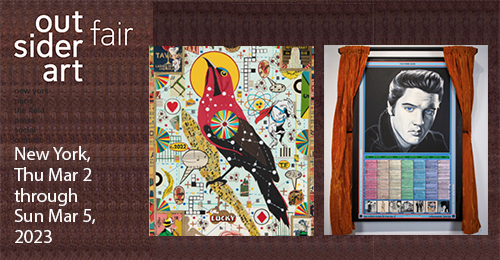
THE ANNUAL SHOWCASE OF UNUSUAL ART IS BACK WITH POST-PANDEMIC VIGOR AND FRESH DISCOVERIES APLENTY
by Edward M. Gómez
If last year’s Outsider Art Fair New York marked the full-bodied, late-pandemic-era return of this most distinctive event on the international art world’s annual calendar of fairs and festive hullabaloos, this year’s OAF promises an even more energetic comeback buoyed by a post-pandemic sense of vigor that has been discernible in our discussions with several of the dealers and other exhibitors who will be taking part in the big bash this time. (OAF New York will open on Thursday, March 2, and run through Sunday, March 5.)

As the art dealer Andrew Edlin, whose eponymous New York gallery shows work by both schooled contemporary artists and their self-taught peers, and whose company, Wide Open Arts, owns and produces the OAF’s New York and Paris editions, told brutjournal, “For newcomers to the outsider art field, OAF has a place for you. For established collectors — longtime aficionados who, like myself, are excited by the originality, beauty, and edginess of this kind of art — there will plenty to discover, too.”
This year’s fair comes at a time when evolving points of view and certain commercial developments have been shaping discussions about outsider art and its market both among specialists and among the wider audience for this kind of art.
They include the increasing involvement of some of the broader art market’s priciest, blue-chip contemporary-art galleries with outsider art, either through their representation of some of the field’s best-known, living artists — Blum & Poe’s relationship with Lonnie Holley, for example — or through their presentations of the high-quality, emblematic works of some of the field’s now-deceased, recognized masters, like that of Venus Over Manhattan’s exhibition of Joseph Yoakum’s drawings in 2019.

Then there is the increasing visibility of outsider artists’ creations in museums, as such institutions feature them in thematic or sometimes solo exhibitions while also acquiring such works for their collections. Also in the mix is the still-percolating argument that the terms “outsider” and “outsider art” should be retired and no longer used at all.
Writing in Cavin-Morris Gallery’s online catalog for its current exhibition, The Go-betweens: New Work by Christine Sefolosha and Sylvain and Ghyslaine Staëlens, Randall Morris, this New York venue’s co-director observes, “Right now, in the field of non-mainstream artists, we have come to a time when the terms ‘outsider,’ ‘art brut,’ and ‘art singulier’ are no longer adequate to describe the work of some creators who are self-taught, visionary — spiritually and otherwise — and who, though they may sell their art to survive, do not make work to respond to the current art canons.”

In Los Angeles, where he just recently opened a branch of his New York gallery, Shrine, Scott Ogden, an experienced collector and dealer of outsider art, has mounted an inaugural group exhibition titled “Death of an Outsider Artist.” Its motivating notion: that continued use of the labels “outsider” and “outsider artist” serve only to ghettoize and, ultimately, to limit the market-growth potential of the art-makers and artistic creations to which they are assigned.
Meanwhile, back in the mainstream of the non-mainstream waters in which the ships of the participants in this year’s OAF are gathering, strong winds are filling their sails — and some remarkable works by both familiar art brut and outsider creators and more recently discovered talents seem sure to guarantee impressive sales. Ahead of the fair’s grand opening, several dealers and exhibitors gave brutjournal a sneak peek at some of the art they’ll be showcasing in their booths.
Speaking of the husband-and-wife team of dealers, Shari Cavin and Randall Morris, whose Cavin-Morris Gallery has been in business for nearly 40 years and may regarded as one of the pioneering and, now, legacy galleries specializing in art brut and outsider art, at this year’s OAF, they’ll be presenting new works by some of their best-known artists.

Among them, look for a large-format drawing by the Japanese artist Monma, who, using little more than plain pencil and colored pencil on paper, conjures up mysterious phantoms that float and collide in his dreamlike, multilayered compositions’ illusionistic depths. (Hailing from the island of Hokkaido in the north of Japan, Monma believes his art-making was motivated by his encounter years ago with a force he calls “The Entity.”)
Cavin-Morris will also feature rarely seen works from Iran, as well as those of the Australian First Nation artist Pauline Sunfly. Also on display: the French artist Evelyne Postic’s drawings in ink on antique marine maps of strange creatures and sprawling organic forms.
Among other works, Fleisher/Ollman, a Philadelphia gallery that, like Cavin-Morris, played a significant role decades ago in creating a market for outsider art in the United States, will present a selection of drawings by the American artist Dorothy F. Foster (1903-1986). Although, in New York, Foster attended a performing-arts high school and then Cooper Union, the renowned school of art, architecture, and engineering, she developed her own mode of making ballpoint-pen drawings on paper torn from magazines and newspapers.
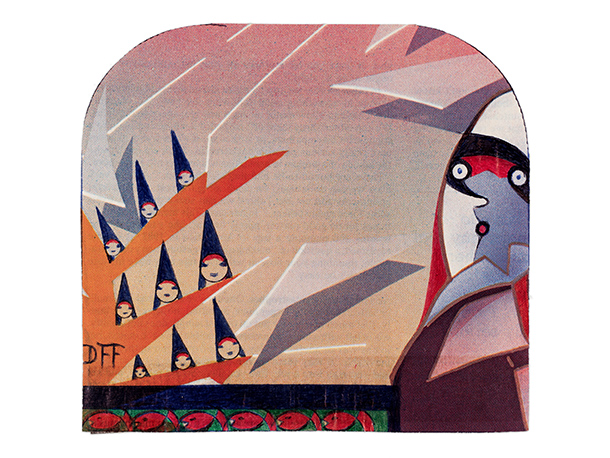
Her neatly balanced compositions, featuring female faces and heads (sometimes topped with cone-shaped hats), sometimes bring to mind those of the classic, British art brut creator Madge Gill (1882-1961), which are also packed with female faces. Fleisher/Ollman will also show the late, atmospheric, mostly abstract drawings of the Idaho-born self-taught artist James Castle (1899-1977).
In fact, striking abstract works will be hard to miss at this year’s fair. Scott Ogden’s Shrine will feature the exuberant, acrylic-on-linen paintings of the Belgian artist Cécile Lobert (born 1992). Their acid-electric pinks, yellows, greens, and blues come together in explosive combinations that are all ferocious energy. At the same time, they boast an innate understanding of gestural rhythm, their contrasting colors’ emotional temperatures, and that essential quality of all good abstract compositions — poise. Look for Lobert’s shrieking streaks and bursts of bright orange and her broad-brushstroke thickets of deep blues, burgundy-scarlet reds, and dirty whites.
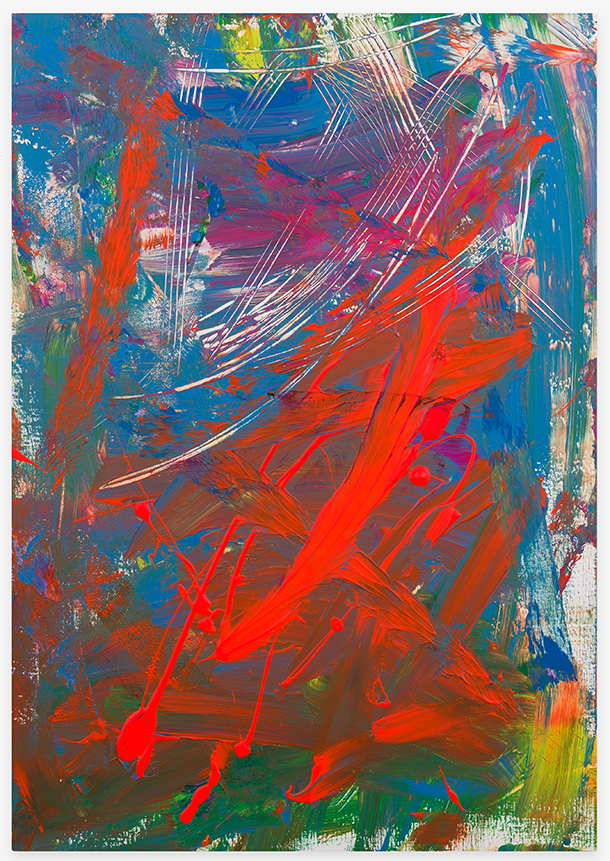
Ogden told me, “Lobert has been non-verbal since childhood, so she appears to communicate through her art. While her paint is still wet, she has been known to scrape hair brushes through her atmospheric color fields, creating rows of parallel lines that seem to come in and out of sharp focus.”
The gallery of Creative Growth Art Center, one of the premier art-workshop facilities for disabled people in the United States, which is located in Oakland, California, will present works by some of its well-known self-taught art-makers; it will also introduce the abstract, mixed-media paintings on paper of Nicole Storm (delicate grilles floating above watery washes of potent hues) and the acrylic-on-paper paintings of Joseph Alef (patches of color in jiggedy-jaggedy shapes, often contained within restless black outlines).
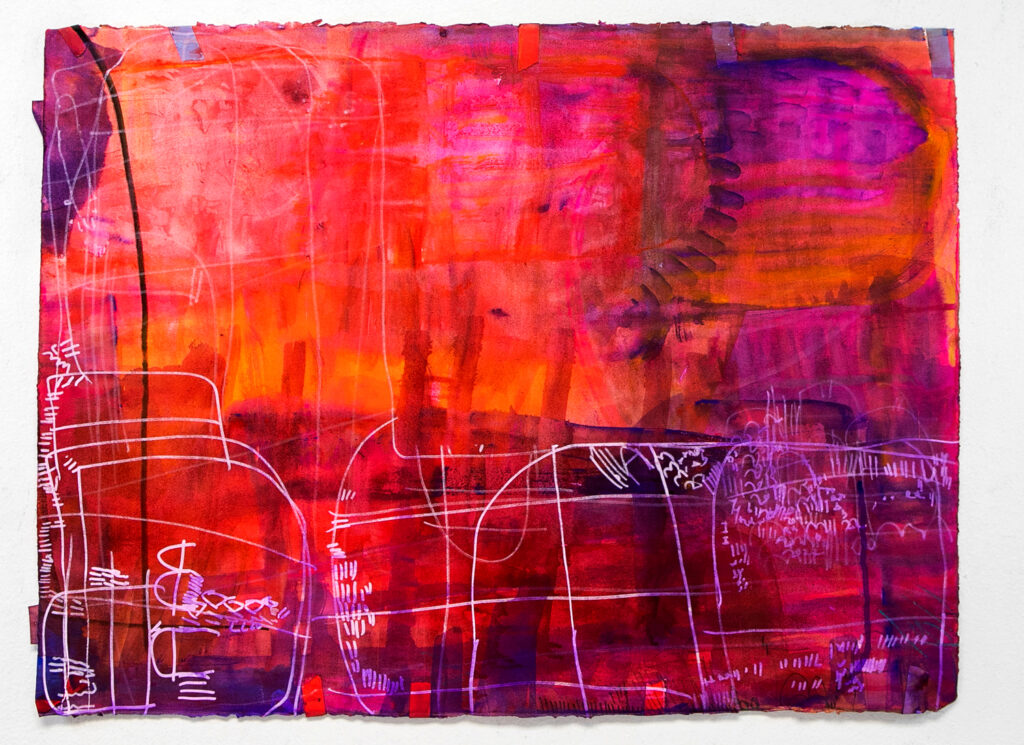
The young British art dealer Jennifer Gilbert, who is based in Manchester, in the north of England, got her start in the art world several years ago at Pallant House Gallery in the city of Chichester, down near the coast, southwest of London. Despite its name, Pallant House Gallery is actually a museum, where Gilbert helped oversee a traveling-exhibition program featuring the works of self-taught artists.
In more recent years, her itinerant Jennifer Lauren Gallery has presented exhibitions at temporary venues in London and elsewhere. Gilbert represents a kind of dynamic, inventive, nimble dealer who is using all of the resources at her disposal to help develop the market for art brut and outsider art in the United Kingdom and Europe. In a relatively short time, her gallery has presented dozens of well-curated exhibitions and has launched or taken part in assorted collaborative projects.

One of Gilbert’s most memorable recent undertakings: an exhibition and related book, conceived and realized along with Vivienne Roberts, the curator-archivist at London’s College of Psychic Studies, honoring the legacy of the late British art historian Roger Cardinal (1940-2019). It was Cardinal who, in 1972, with his book Outsider Art (Studio Vista) introduced the art brut phenomenon to the English-speaking world.
In effect, its title both captured the spirit of a category of art-making the French modern artist Jean Dubuffet had identified and named back in the 1940s and also broadened its meaning. Gilbert and Roberts presented their two-part homage to Cardinal in Margate, England, late last year; taking a phrase from the art historian, writer, and teacher’s personal journals, both the exhibition and the book were titled “Roger Cardinal: Castles are Everywhere.”
This year at the OAF, Gilbert’s Jennifer Lauren Gallery will present Cara Macwilliam’s exquisite abstract drawings in watercolor pencil on paper. In them, strands of color, like long, languid lengths of thread, billow and blow through their compositions’ pictorial space, coming together in bow-like shapes and then splitting off again like intergalactic flotsam. Gilbert will also show the Japanese artist Yoshihiro Watanabe’s delicate animal figures made of folded oak leaves and the Spanish artist Miguel Ángel Hernando’s gel-pen drawings of animals and imaginary creatures.
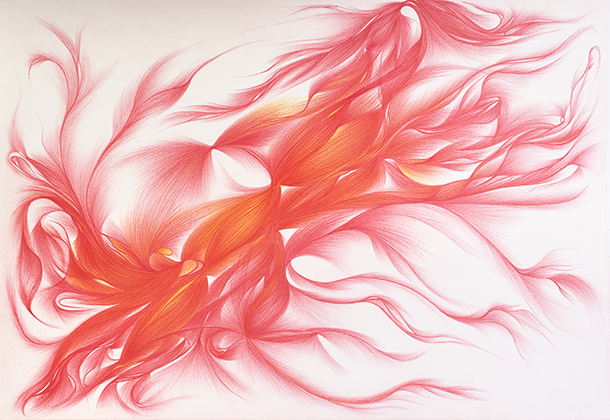
Among other longtime participants in the Outsider Art Fair, New York’s Ricco/Maresca Gallery will be showing the recently emerged drawings in ink and gouache on paper of the American artist Grant Wallace (1868-1954), who was interested in the occult, reincarnation, extraterrestrial life, and telepathy (which he called “mental radio”).
Dealer Frank Maresca told brutjournal, “A few months ago, our tribute booth featuring works that had been owned by the late Siri von Reis [1931-2021], a botanist and major collector of outsider art, sold out at the Art Dealers Association of America’s 2022 Art Show. Now, at this year’s OAF, we’ll be showing newly released pieces from Reis’s collection, including works by such definitive art brut and outsider artists as Morton Bartlett, Minnie Evans, Bill Traylor, Frank Jones, and Adolf Wölfli.”
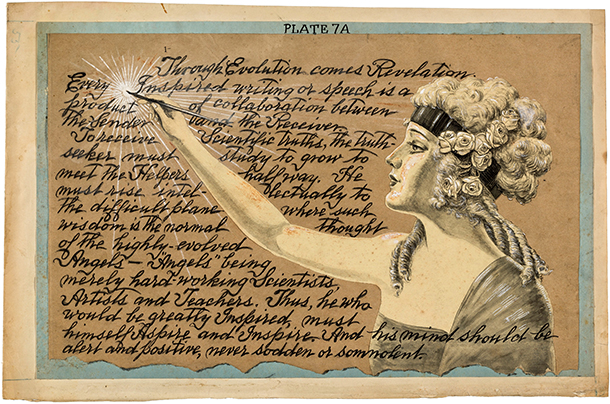
ink, gouache, and watercolor on paper, 11 x 17.25 inches (27.9 x 43.8 centimeters). Photo courtesy of Ricco/Maresca Gallery
Look for examples of classic outsider art from Chicago’s Carl Hammer Gallery, too, including embellished photo self-portraits by Lee Godie and one of that artist’s lusciously red, profile portrait drawings incorporating a black-and-white self-portrait photo. Hammer will also offer two small-format gems by the Swiss art brut master Wölfli (1864-1930), whose richly colored, superbly executed drawings on paper were among the exemplary, unusual finds that led Dubuffet to coin a name for the hard-to-classify creations of visionary autodidacts.
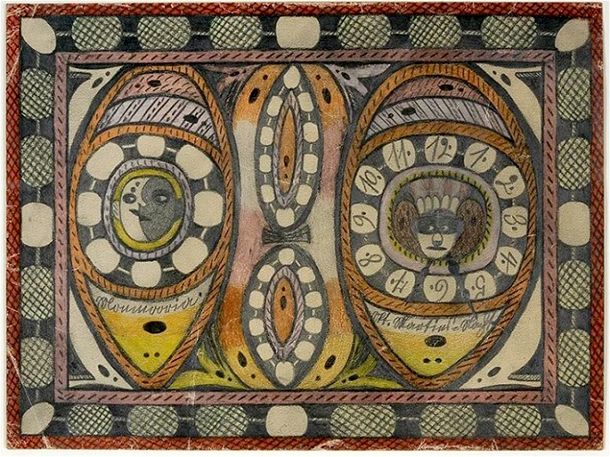
The American self-taught painter Valton Tyler (1944-2017) spent most of his life living in Dallas, Texas, where he produced some of the late-modern era’s most bizarre images. It’s largely due to the fact that his art was impossible to easily classify using familiar style or genre labels that Tyler earned his outsider status; he was also an unsinkable eccentric.
Making its debut at the OAF, this year, Valley House Gallery will present a booth filled with Tyler’s drawings and small and large oil paintings of his otherworldly, techno-baroque landscapes. In them, structures resembling plants, robotic animals, and buildings at the same time hunker down against the horizon line. Tyler once told me that he regarded his “shapes,” as he called them, as sentient entities possessing spirits or souls.
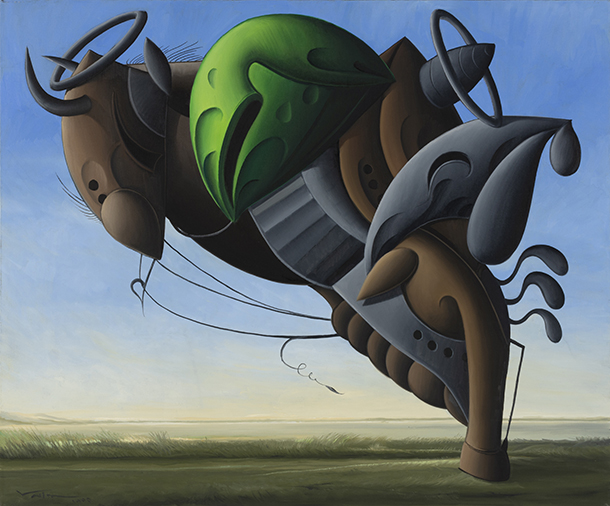
Note: The documentary film Valton Tyler: Flesh Is Fiction, which I produced with the cinematographer Chris Shields in 2017, can be viewed in its entirety, free of charge, on brutjournal’s website. See the Big Page, here. In the film, Tyler recalls his childhood in East Texas and the development of his art.
The veteran dealer Aarne Anton, who was long known for selling art through his Manhattan-based gallery, American Primitive, is now based in Pomona, New York, where his by-appointment presentation of art and vernacular objects unfolds under the name and in the expansive context of his Nexus Singularity virtual gallery. (Its website serves as the locus of the nexus.)
Anton said, “To this year’s OAF, I’ll be bringing a broad range of art reflecting my outsider art inspiration, with roots in American folk art that at times has turned obsessive. Behind the door to the Nexus Singularity, visitors will experience art rooted in past connections, as well as anonymous works of mystery that contrast with those of such contemporary artists as J.J. Cromer, Daniel Martín Díaz, Lonnie Holley, O.L. Samuels, and Terry Turrell.”

Among the more unusual items Anton will show are figures and animal sculptures made from gnarly tree roots by Moses Ogden (1844-1919), a self-taught artist who created a site-specific art environment called “Moses Ogden’s Wonderland” in the village of Angelica in the southwestern corner of the state of New York. Anton noted, “There are certain spiritual and supernatural aspects to Ogden’s works.”
Mystery and fine craftsmanship are hallmarks, too, of the meticulously rendered, dense compositions of the artist Yuichiro Ukai (born 1995), who makes paintings on cardboard using markers, colored pencil, and ink, and of the dramatically reworked garments created by Nana Yamazaki (born 1994). From Kyoto, Japan, the dealer Yukiko Koide of Yukiko Koide Presents, a longtime OAF exhibitor, will be showing works by Ukai, Yamazaki, and other Japanese artists.
Ukai’s pictures bring together dinosaurs, robots, monsters, samurai and traditional Japanese figures, and manga characters in sprawling, dense compositions. Years ago, when Yamazaki first started making art, she drew models she found in fashion magazines. To make her sculptural textile works, she uses lengths of thread to tie knots in shirts or other pieces of clothing, cutting them randomly so that they hang off her fabrics’ surfaces like shaggy fur. Her knotting technique causes her raw-material garments to pucker and assume odd shapes and textures.
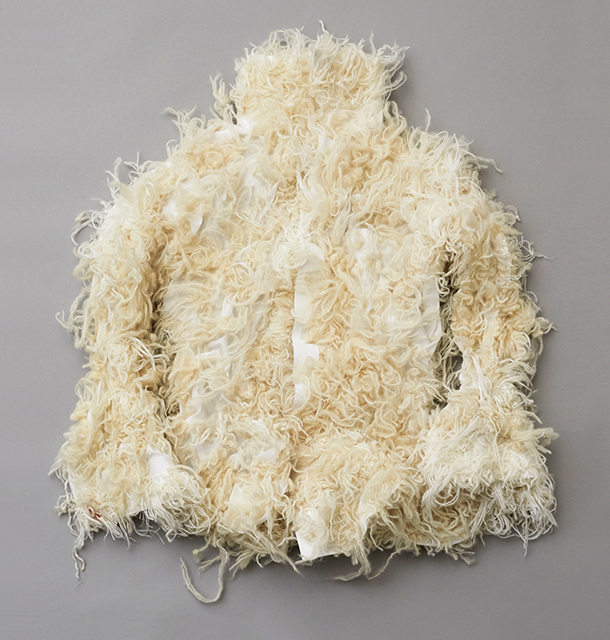
Both Ukai and Yamazaki are associated with the art-making program at Atelier Yamanami in Shiga Prefecture, in west-central Japan, immediately to the east of Kyoto. It is one of the most well developed and respected programs of its kind among institutions serving disabled people in Japan.
Along with California’s Creative Growth Art Center, several other art-workshop programs for the disabled in the U.S. will present their participating artists’ works at this year’s OAF, including LAND Gallery, which is based in Brooklyn, and Project Onward, which is located in Chicago. LAND will show the colored-pencil-on-paper drawings of James Rosa, who uses templates and outlines traced from various objects that he finds around him to produce vibrant, jazzy geometric-abstract compositions.
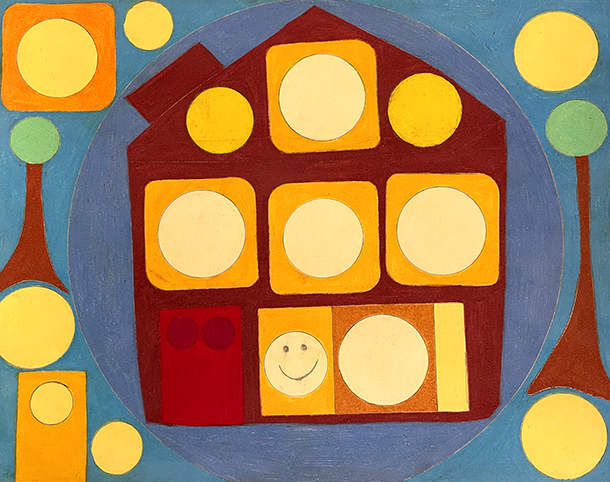
Project Onward will present paintings by Ruby Bradford, a big fan of Superman and cats. Her pictures feature felines in helicopters and high-speed trains and, of course, in Superman’s blue-and-red superhero costume. Other Project Onward artists’ works on display will include Michael Bryant’s portraits of African American subjects and party scenes, and Louis DeMarco’s paintings of the mapped structure of the brain, buildings, and musicians performing on stage.
DeMarco plays bass guitar in the rock band Lightning Speed and composes music. He sometimes incorporates declarative slogans into his compositions. A photo on Project Onward’s website shows the artist at work on a large mural featuring, in big yellow letters, the admonishment “PAY ATTENTION.”
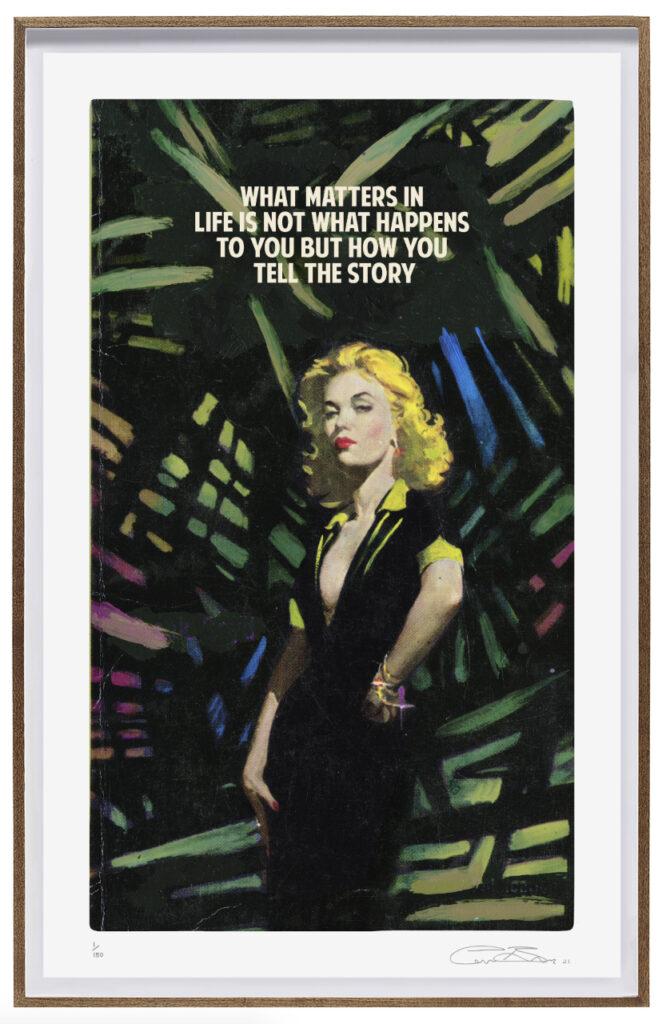
Another longtime OAF exhibitor, the New York dealer Marion Harris, will show sculptures of birds and other animals by the ceramist Susan Halls and will reintroduce a duo of British artists who present themselves as “The Connor Brothers.” She first showed their work in 2014, just a few years after they first appeared on the U.S. contemporary-art scene as the fictional American twins Franklyn and Brendan Connor.
(Speaking of birds, curated exhibitions on view within this year’s OAF will include We Are Birds, organized by Randall Poster and Andrew Edlin in support of the National Audubon Society, and The Life and Death of Elvis Presley: A Suite, featuring paintings by the visionary American artist and architect Paul Laffoley (1935-2015).)
As Harris puts it, the Connor Brothers “maintained their anonymity with a dramatic, imaginary biography that claimed that they had been brought up in a Californian cult known as ‘The Family.’” In addition, she explains, “The story goes that they escaped that life when they were 16 years old and traveled as hobos on trains across the U.S. to New York, where they gave themselves an eventual, if fabulist, address in Brooklyn. By exploring their surroundings and sharing their discoveries with each other through their notebooks and a fantasy find of a cache of Mills and Boons romance novels, the Connor Brothers began educating themselves and creating their artworks together.”
The artists’ paintings include images of authentic-looking, thoroughly fake, old Penguin paperbacks (example, from the well-known British publisher’s Modern Philosophy series: The Truth: You Couldn’t Make It Up) and retro-style, poster-like images with sassy slogans (“What matters in life is not what happens to you but how you tell the story”). Harris notes that the Connor Brothers’ “obsession with truth seems particularly relevant in the current, ‘post-truth’ climate of fake news and social-media obsession.”
Dealer Andrew Edlin’s gallery recently became the U.S. representative of the well-known artist George Widener, an autistic savant whose paintings and mixed-media works give tangible form to and are based on complex mathematical calculations. They are related to the dates of certain historical events, especially disasters, from the sinking of the RMS Titanic in 1912 to innumerable hurricanes and other calamities.
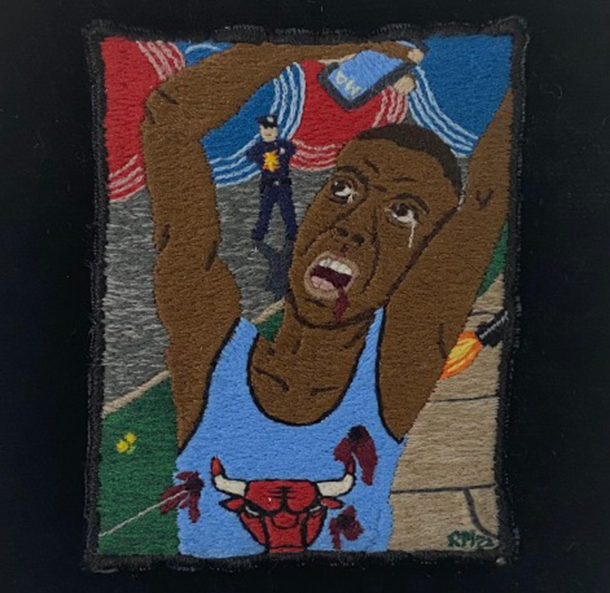
Edlin’s OAF presentation will also feature small, colorful, embroidered thread-and-fabric pictures made by Ray Materson, a Michigan-based artist who, in the past, served a long prison sentence in Connecticut for drug-related robberies. Materson, who has said that he “knew how to sew a button onto a shirt and do minor mending” and stitched his way to freedom, began making his unique artworks when he was living behind bars. He used fabric swatches from bedsheets or white boxer shorts and colored threads extracted from socks to make his precisely embroidered portraits of baseball players and scenes inspired by pictures in magazines.
For several years now, Edlin has represented the Italian artist Domenico Zindato, who lives in Mexico and normally works in colored ink on paper. The boldly colored sections of his abstract compositions are filled with flowing patterns whose motifs evoke the spirit of prehistoric cave paintings and archetypal symbols. At this year’s OAF, Edlin will show Zindato’s newest works, in which, the dealer says, “he has moved from paper to canvas with fantastic results.”
Tom di Maria, who served as Creative Growth’s executive director for many years and recently retired, now serves as that organization’s director emeritus. Taking the pulse of the outsider art scene and the broader art world today, he offered some comments that help set the stage for this year’s Outsider Art Fair.
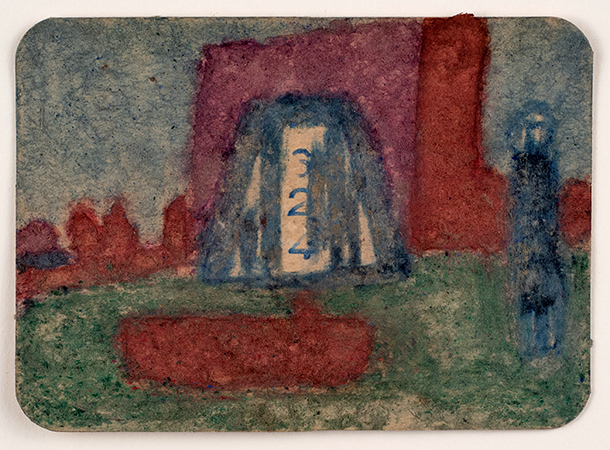
Di Maria told me, “I think the pandemic has been a great equalizer in terms of people’s appreciation of life’s pleasures, including art. [Many] people seem to have a renewed interest in how they experience and respond to the world, and this has further opened the door to appreciating the work of self-taught artists.”
A well-informed, longtime observer of the outsider art world’s — and market’s — evolution, di Maria noted, “Dubuffet’s notion of the artist hidden from society and working in secrecy has given way to the idea of an artist whose work is visceral, immediate, and full of human spirit — qualities that people desperately missed during the coronavirus lockdowns. The return to human encounters benefits self-taught artists, as their work often embodies these qualities.”
Get ready for such encounters and confrontations at this year’s OAF with works of art whose unusualness and power to provoke and charm, often at the same time, are their calling cards. The pandemic isn’t over but it has notably receded, and the Outsider Art Fair, still unpredictable after many years, is ready to deliver the goods.
[Coming tomorrow, March 1, 2023, in the magazine’s March issue: A round-up of outsider art dealers comments and observations about collecting in this specialized, increasingly popular field today.]


